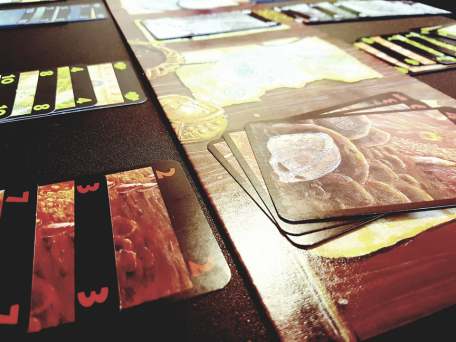Pick up your map and safari hat. You’re now an intrepid explorer, ready to embark on expeditions to far-flung corners of the globe and make the discoveries you’ve been dreaming of! Set out towards the Himalayas, the bottom of the ocean, the Central American rain forest, volcanic islands and harsh Egyptian desert climates to unearth lost cities. Your globetrotting jaunts won’t come cheap, though. You’ll need financial backing first due to a limited supply of resources. Let’s hope you can pay back those investments, otherwise you’ll be returning home in severe debt…

Lost cities is a two-player hand management game that revolves around the risk and reward factor of playing cards into your own set. The game consists of a board placed between the two players and 5 sets of 12 cards. Each card set is a different colour – red, blue, green, yellow and white – representing the 5 different locations mentioned above. Each coloured set has cards numbered from 2 – 10 plus three investment cards. 45 expedition cards and 15 investment cards in total.
At the start of the game you’ll shuffle all 60 cards and place them face down next to the game board. Each player then receives 8 cards. Looking at the game board, you’ll notice 5 card spaces, one of each colour. These will be used as discard piles and also to indicate where you should begin expeditions of a corresponding colour.
On your turn you have two options. You may use one of the cards in your hand to begin a new expedition, or you can discard a card face up on the game board. You’ll probably be eager to start your journey, but remember the costs! Each expedition costs $20,000. Are you sure you can make that money back and not incur a loss? During an expedition you’ll lay down cards of a certain colour in a column, beginning from the same coloured space on the game board. You must ensure that by the end of the game the combined total of each expedition equals more than 20 (i.e. $20,000) in order to score points. The problem is, once you’ve placed a card the next one must always be higher in value. Remember, each set of cards is numbered from 2 -10. Beginning an expedition with an 8 would be unwise, unless you have both the 9 and 10 in your hand, or you feel confident you can obtain them from either the discard piles or the draw pile. If your opponent secretly has those cards in their hand and is venturing on the same expedition, you’re in trouble. Ideally, you’ll want to begin an expedition with lowest value possible.

What if you’ve started a red expedition with a 4 and then later pick up a 3? Well, it’s too late, that card is no use to you now. Best to discard that card on the game board. Be sure to check you’re opponent’s progress, though. Perhaps they’ve also begun a red expedition with a 2. If you discard the 3 then you may as well place the card right in their hand. There is a benefit, therefore, to keeping cards in your hand that you don’t need if it prevents your opponent from accessing them.
Lost Cities has an extremely simple mechanic but creates interesting dilemmas and engaging game-play. You want to get going with a green expedition but you’re waiting for low value cards, let’s say. Should you continue to bide your time or just begin with a 6 and hope for the best? Look at what your opponent has played so far. How likely is it that there are green cards you need at the top of the draw pile? Throughout the game you’ll frequently be lacking the cards you need at the right time and must consider your moves with all the information available to you.
Risk-takers will appreciate the added investment aspect of the game. If you’re feeling particularly confident about your Nepalese mountain trek then why not secure a large investment first? If you place an investment card at the start of your expedition it will multiply that column’s total score. Sounds great, but if you don’t break even on that expedition then you’ll be multiplying your loss. Ouch. There are 3 investment cards of each colour and you can use more than one per expedition. If you make a profit on an expedition backed by more than one investment then you’ll really be making it rain, but score lower than 20 and you may as well stay in the Himalayas and start living out your life with only the Abominable Snowman for company.

The game ends when the draw pile expires. You can manipulate the length of the game and either draw out proceedings by taking cards from the discard piles instead, or speed things up by choosing the draw pile every turn. What suits your purpose will depend on your progress. I love the rounds that create a hilarious desperation as they get closer to concluding. There may be five cards left in the draw pile, but if you don’t start a yellow expedition now with a card value of 7 then you’re opponent will finish with the upper hand. Can you make a profit before time is up?
Some may find the math-heavy scoring system a little awkward or off-putting, especially when investment cards are involved. It took me a few minutes to make sense of it as I’m woefully inept when it comes to maths. I’m also aware that the theme is completely tacked on – this is nothing but a game of numerical organisation. However, I love using my imagination when I play board games so I still like to embrace the story. Paper-thin theme and maths homework aside, I really think this is an excellent 2-player game. The gamble of drawing the cards you need to fulfill expeditions, especially when you’ve added investment modifiers, allows for agonising decisions and a high stress factor in a 10-15 minute game.
Good luck on your worldwide quest for high value cards!
Lost Cities scores 8 compasses out of 10













